Best Pet Turtle
Different people have different expectations when it comes to defining the best pet turtle. Some want a turtle that lives long, while others want a turtle that won’t shy away from attention.
Yet still, others prefer a colorful or unique-looking turtle. Regardless of what you look for, turtles are among the most popular pets.
While there are hundreds of different turtle species in the world, not all of them make good pets. Some grow way too big for domestication, while others may be illegal to own. You need to do your research before acquiring a turtle.
It is also important to know that most turtles are aquatic and as such require an aquatic setup. When housed outdoors, they require a small pond.
When housed indoors, they require an aquarium with a filtration system and submersible pumps. Additionally, a third of the water needs to be changed regularly. This is absolutely important if the water is to be clean and habitable.
Here is a list of the best pet turtles out there. These turtles are trouble-free, easy to care for, and gorgeous.
1. Pond Slider (Red-Eared Slider / Cumberland Slider)
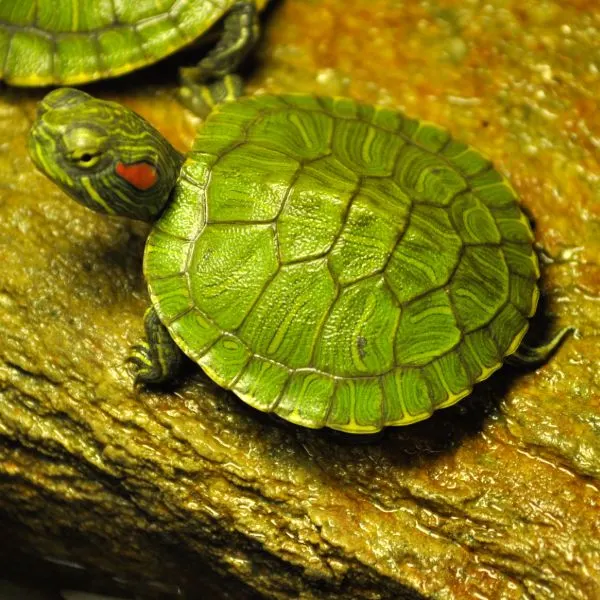
Quick Facts
- Experience Level: Intermediate
- Family: Emydidae
- Scientific Name: Trachemys Scripta elegans/ Trachemys Scripta troostii
- Common Names: Red-eared terrapin, red-eared slider turtle, red-eared turtle, slider turtle, and water slider turtle
- Adult Size: 6 to 12 inches
- Lifespan: 20 to 40 years
- Average Price Range: $5 to $20
Quick Care Requirements
- Tank Size: 40 to 100 gallons
- Food: Krill, shrimp, fish, snails, insect / Commercial turtle food
- UVB Lighting: Needed
- Ambient Temperature: 75 to 80 F
- Water Temperature: 75 to 84 F
- Basking Spot Temperature: 90 F
Both the Cumberland slider and the red-eared slider belong to the same species – pond sliders (Trachemys scripta). Their care requirements are the same, and they look very similar.
As with most turtles, they are long-lived. They grow to between 6 inches and a foot in size. This pond slider can live well into its 60s.
With good care, you should expect a pond slider to live for about 40 years. They eat seafood such as shrimp, insects, and commercial turtle food.
They are easy to find, easy to acquire, and relatively simple to care for. Additionally, they make very cute pets and do not bite or scratch when touched. For turtle, they don’t mind being handled much. They are definitely one of the most popular pet turtle species in the world.
They are, however, not the easiest pets to keep and will die if not cared for properly. Because they are super easy to find and very affordable, many people who aren’t really into reptiles end up acquiring one.
These include kids who beg their parents into getting them one or people who simply want a pet around the home. Since they live so long, many such people grow tired of these adorable turtles after some years (it could be after a couple of years or after 10 years) and release them into the wild which is wrong.
I recommend the slider for people with some experience with keeping reptiles or aquatic pets. If this is your first time caring for a reptile or aquatic pet, you should be able to keep this pet as far as you are attentive to the slider’s needs.
For more check out the Red Eared Slider Care Guide
2. Eastern Box Turtle

Quick Facts
- Experience Level: Beginner
- Family: Emydidae
- Scientific Name: Terrapene carolina carolina
- Common Names: Eastern box turtle, Common box turtle
- Adult Size: 4.33 to 7 inches
- Lifespan: 40 to 100 years
- Average Price Range: $150 to $400
Quick Care Requirements
- Tank Size: 20 to 50 gallons (an outdoor enclosure is best)
- Outdoor enclosure size: 4 x 4 ft.
- Food: Live insects and vegetables
- UVB Lighting: Needed
- Temperature Range: 75 to 80 F
- Basking Spot Temperature: 95 F
The eastern box turtle may just be the most popular box turtle kept as a pet. They are called eastern box turtles as they are box turtles endemic to the Eastern United States.
Unlike the other turtles in this article, they are not aquatic, and as such need a terrarium, and not an aquarium. You can also house them outdoors; just make sure they cannot escape.
They are quite small and grow to be about 6 inches as adults. They accept whatever food you feed them and as such, you need to be careful about what you give them.
It’s best to feed them live insects, snails, and grubs. In addition to this, feed them vegetables such as romaine lettuce, dandelions, collard greens, and many other vegetables.
In all, they are easy to feed and easy to bond with especially during feeding time. All of which makes them excellent pets.
Remember they live long. They have been known to live up to 100 years old. You should expect them to live to be at least 40 years.
This long-term commitment isn’t for everyone. Apart from their longevity, they are excellent land turtles. If you want a land turtle/tortoise, I recommend the eastern box turtle.
The box turtle is an excellent reptile for first-time pet reptile keepers. They are hardy and easy to feed and house. I consider them the best pet turtles for beginners. They are also among the most common pet turtles.
For more check out the Eastern Box Turtle Care Guide
3. Painted Turtle
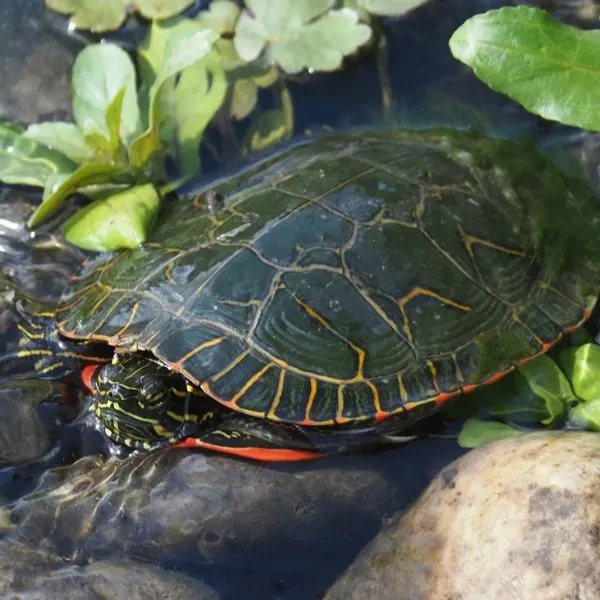
Quick Facts
- Experience Level: Beginners
- Family: Emydidae
- Scientific Name: Chrysemys picta
- Common Names: Painted turtle, skilpot
- Adult Size: 6 to 8 inches
- Lifespan: 25 to 30 years
- Average Price Range: $29 to $80
Quick Care Requirements
- Tank Size: 15 to 20-gallon tank
- Food: Commercial turtle food/insects and vegetables
- UVB Lighting: Needed
- Temperature Range: 75 to 85 F
- Water temperature: 75 F
- Basking Spot Temperature: 95 F
The painted turtle has four subspecies namely the eastern painted turtle, midland painted turtle, southern painted turtle, and western painted turtle.
The subspecies are named after where they are found geographically. These gorgeous reptiles are great as beginners’ pets and can live to be more than 55 (although they generally live to be about 25 to 30 years). As you can see, they require commitment.
They are easy to find and acquire, fun to keep, and nice to look at. There are very few turtle enthusiasts who won’t be impressed by this turtle. Feeding them is stress-free as they accept commercially made turtle food.
This is sure to give them all the nutrients they need including vitamin D3. They grow to be just 6 to 8 inches in length, which makes them manageable pets.
There is nothing bad to be said about this turtle. As with all turtles, wash your hands before and after touching or handling them.
I recommend this turtle to first-time aquatic pet keepers and experienced aquatic pet keepers who want an attractive and striking turtle to keep as a display pet.
For more check out the Painted Turtle Care Guide
4. False Map Turtle
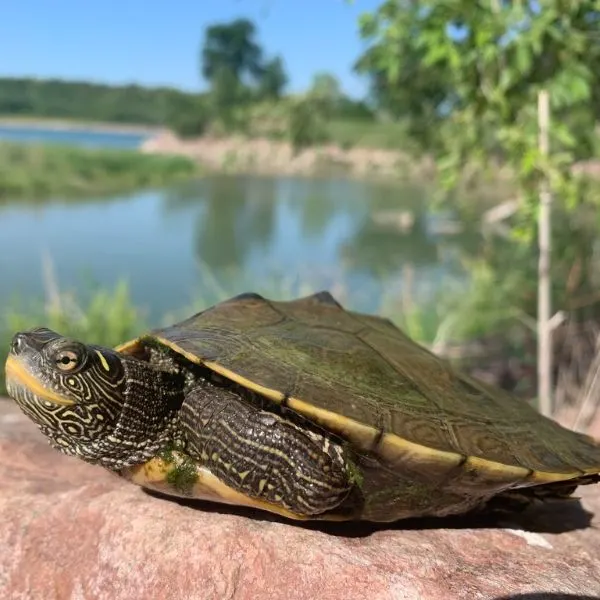
Quick Facts
- Experience Level: Beginner
- Family: Emydidae
- Scientific Name: Graptemys pseudogeographica pseudogeographica
- Common Names: False map turtle
- Adult Size: 4 to 10 inches
- Lifespan: 30 to 50 years
- Average Price Range: $5 to $50
Quick Care Requirements
- Tank Size: 25 to 100 gallons
- Food: Commercial aquatic turtle food/insects and vegetables
- UVB Lighting: Needed
- Water temperature: 75 F
- Ambient temperature Range: 80 to 85 F
- Basking Spot Temperature: 85 to 90 F
This is another north American aquatic turtle. G. p. pseudogeographica is the nominal false map turtle subspecies.
The other false map turtle subspecies include the Mississippi map turtle (G. p. kohnii). They are called map turtles because of the lines that run down their bodies and shells which resemble contour lines.
These turtles are simply gorgeous. The contour lines, and raised saw-like back set them apart from other turtles. If you’re looking for display pet turtles, you can’t go wrong with these. In terms of care, there couldn’t be an easier turtle to care for.
They are relatively small even for a small turtle. The females are much bigger than the males though. While the male does well in a 20 to 25-gallon aquarium, a large female needs a 75-gallon tank.
They eat insects and veggies as well as commercial turtle food. Apart from the small setback of having to acquire a large aquarium for the potential female, they are hardy turtles and super easy to care for.
While they may not be as long-lived as other turtles, expect them to live to 33 years. Make sure you are ready to care for a turtle before getting one. Additionally, if you must abandon one ensure you find a suitable home for it.
I recommend this chelonian to both first-timers and experienced reptile/aquatic pet keepers.
For more check out the False Map Turtle Care Guide.
5. African Aquatic Sideneck Turtle
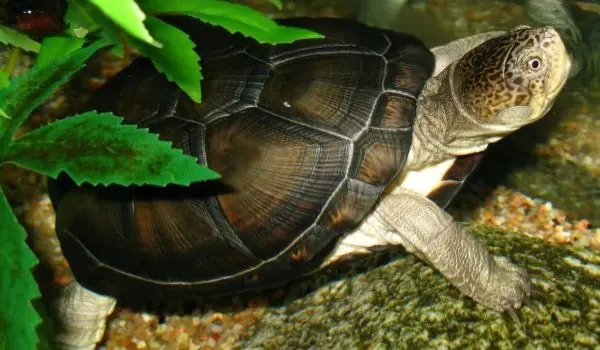
Quick Facts
- Experience Level: Intermediate
- Family: Pelomedusidae
- Scientific Name: Pelusios castaneus
- Common Names: African mud turtle, African sideneck turtle, African aquatic sideneck turtle
- Adult Size: 7 to 11 inches
- Lifespan: 25 to 50 years
- Average Price Range: $30 to $50
Quick Care Requirements
- Tank Size: 40 gallons
- Food: Fish, chicken, snails, and greens/ commercial turtle food
- UVB Lighting: Needed
- Temperature Range: 80 – 85 F
- Water temperature: 75 F
- Basking Spot Temperature: 95 F
The African sideneck turtle is such a unique-looking pet. This sets it aside from other common pet turtles that normally originate in North America.
Their shell has the appearance of that of a land turtle. Also, they have cute little smiling faces. They grow to between 7 and 12 inches and usually live for a few decades (30 years). Although they aren’t that big, they require a large tank to be comfortable.
Their diet is quite different from other turtles. While it isn’t advisable to feed North American turtles meat, the African sideneck turtle is an exception as it eats meat. It eats cooked chicken, beef heart, and fish.
Also, feed them greens such as collard greens and romaine lettuce. As an adult, the African sideneck turtle prefers to eat a lot of leafy green vegetables. Another excellent way to feed it is by using commercial turtle food.
The positives of this marvelous turtle are its cute smiling face and its unique appearance. Additionally, they are relatively easy to care for. Lastly, they don’t hibernate as American turtles do. They are active all year round.
On the other hand, they are less common and more difficult to find than American turtles.
In all, the African sideneck turtle is one of the best pet turtles you can keep. owing to their easy care, food preferences, and year-long active lifestyle.
I recommend this turtle to experienced reptile/aquatic pet keepers and first-time aquatic pet keepers who are ready to put in the work.
For more check out the African Sideneck Care Guide
6. Razor-Backed Musk Turtles
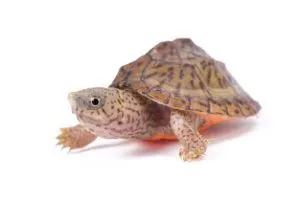
Quick Facts
- Experience Level: Beginners
- Family: Kinosternidae
- Scientific Name: Sternotherus carinatus
- Common Names: razor-backed musk turtle
- Adult Size: 6 inches
- Lifespan: 20 years
- Average Price Range: $35 to $100
Quick Care Requirements
- Tank Size: 30 gallons
- Food: Crustaceans, fish, bloodworm, and insects/ commercial aquatic turtle diet
- UVB Lighting: Needed
- Water temperature: 73 to 78 F
- Temperature Range: 75 to 85 F
- Basking temperature: 90 F
Musk turtles are small turtles. Even the razor-backed musk turtle, which is the biggest, grows to be just 6 inches in length. Also, unlike other turtles mentioned in this article, musk turtles are carnivorous.
They eat snails, fish, bloodworms, mealworms, and many other foods. However, they can be fed aquatic turtle diets such as Mazuri Aquatic Turtle Diet. They grow to be 20 years, on average. For a turtle, this is quite a moderate lifespan.
They don’t require large aquariums although, a large aquarium provides more comfort and ensures the turtle is least stressed. I recommend a tank that is about 30 gallons large.
Feeding them is also really simple as they accept commercially made aquatic turtle diets. Conventional turtle food and leafy greens in their diets would help them lead a long, healthy life.
You can supplement this diet with mealworms, bloodworms, crickets, snails, fish, and many more. They are also easy to find.
You can find them online from reputable breeders and even at pet stores. They also live relatively peacefully alongside other pet turtles in the same tank.
The only negative when it comes to razor-back musk turtles is their shyness. These cautious turtles will take some time to get used to you and their environment.
Make sure that you give these animals access to food, clean water, and alone time to get the best behavior out of them. They are more display pets and do not appreciate being held.
This is especially important to keep in mind if you have kids at home who’d want to pick them up. Make sure that you have a space for these turtles where they can be left alone without any disturbances.
If you have kids in the house, these animals might not be the best fit for you. Ensure that your children know that these turtles need their space and shouldn’t be held to avoid any accidents or injuries.
I recommend this turtle to both first-time aquatic/reptile pet keepers and experienced reptile and aquatic pet owners.
For more check out the Razorback Musk Turtle Care Guide
7. Mississippi Map Turtle

Quick Facts
- Experience Level: Beginner
- Family: Emydidae
- Scientific Name: Graptemys pseudogeographica kohni
- Common Names: sawback,
- Adult Size: 5 to 10 inches
- Lifespan: 30 years
- Average Price Range: $20 – $40 (Hatchlings)
Quick Care Requirements
- Tank Size: 25 to 100 gallons
- Food: Commercial aquatic turtle food/insects and vegetables
- UVB Lighting: Needed
- Water Temperature: 75 °F
- Ambient Temperature Range: 80 to 85 °F
- Basking Spot Temperature: 85 to 90 °F
The Mississippi map turtle is one of the more popular turtles kept as pets. This chelonian is of the same species as the false map turtles. As such, a lot of their needs are identical.
This subspecies is endemic to the Mississippi river which lends the subspecies its name. The species is endemic to the Mississippi River and its tributaries from Missouri and Illinois southward to Louisiana. The species can be found in as many as ten states.
The Mississippi map turtle has gray carapaces with yellow markings that resemble contours on a map. The carapace has a lateral ridge down the middle. This ridge resembles a saw and this characteristic gives the turtle another of its common name – sawback.
The species is popular among aquarists and turtle enthusiasts as they are quite fun to watch.
This chelonian reaches a sizable length at maturity with females being much larger than males. Females can reach a carapace length of 6 to 10 inches while males can reach a carapace length of 3 to 5 inches.
The species can grow to over 30 years although when kept as pets they usually grow to 15 to 20 years.
The turtle feeds on commercial turtle foods, leafy greens, and proteins such as insects, fish, mollusks, and crustaceans.
This turtle requires a moderately sized aquarium for males and a large aquarium for females.
Overall, these turtles are relatively easy to care for even for beginners.
For more check out the Mississippi Map Turtle Care Guide
8. Common Musk Turtle

Quick Facts
- Experience Level: Beginner
- Family: Kinosternidae
- Scientific Name: Sternotherus odoratus
- Common Names: Eastern musk turtle, stinkpot, common musk turtle
- Adult Size: 3 to 5 inches
- Lifespan: 30 to 50 years
- Average Price Range: $30 to $50
Quick Care Requirements
- Tank Size: 30 to 50 gallons
- Food: Crustaceans, fish, bloodworm, and insects/ commercial aquatic turtle diet
- UVB Lighting: Needed
- Water Temperature: 75 to 80 °F
- Temperature Range: 75 to 85 °F
- Basking Temperature: 90 °F
The common musk is also known as the stinkpot and the eastern musk turtle. It is a commonly kept turtle species. This is mainly down to the size. In comparison to other turtles such as sliders, the stinkpot is tiny.
The species is endemic to the Eastern United States (no wonder it is also known as the eastern musk turtle) from Maine to Florida. Inwards, they can be found as far west as Texas.
The species have a carapace with a length of 2 to 5.5 inches and an average mass of about 0.7 lb or 318 grams. The carapace is highly domed and brown, gray, or black in coloration. The legs of this turtle are short but the neck is long.
The turtle is known as the stinkpot because of the foul odor it releases when stressed.
The stinkpot is relatively easy to care for. Ensure that the water temperature is around 80 degrees Fahrenheit and provide a basking location with temperatures of about 90 degrees Fahrenheit. The species also require UVB lighting.
In terms of feeding, the species is predominantly carnivorous although they may accept vegetables such as leafy greens. Make sure to offer although most will reject it. They prefer protein-rich foods such as insects, fish, crustaceans, and even commercial aquatic turtle diets.
I recommend this turtle to first-timers and experienced aquatic pet keepers who don’t have much space within their homes.
For more check out the Musk Turtle Care Guide
9. Peninsula Cooter
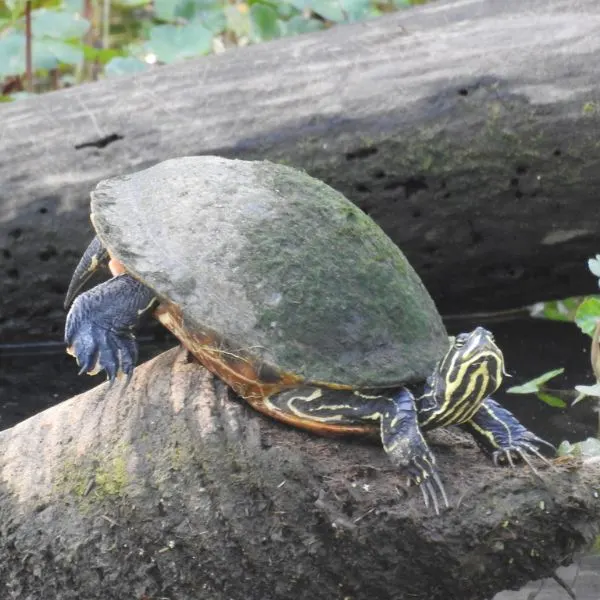
Quick Facts
- Experience Level: Intermediate
- Family: Emydidae
- Scientific Name: Pseudemys peninsularis
- Common Names: peninsula cooter
- Adult Size: 9 to 13 inches
- Lifespan: 30 years
- Average Price Range: $25 to $50
Quick Care Requirements
- Tank Size: 75 to 100 gallons
- Food: Leafy greens such as collard greens and romaine lettuce, edible aquatic plants such as pondweed, insects, mice, and fish
- UVB Lighting: Needed
- Ambient Temperature: 80 °F
- Water Temperature: 75 to 80 °F
- Basking Spot Temperature: 85 to 90 °F
The peninsula cooter is endemic to the Florida peninsula. It is easy to see where this turtle gets its common name.
As with other river cooters, the peninsula cooter is quite large with some individuals reaching a length of 16 inches and a weight of 35 lb although their general length is between 9 and 13 inches. The weight of the species is 5 to 15 lb or 2 to 7 kg.
This cooter has dark carapaces with yellow lines. Unlike the red-bellied cooter which we will get to later on, the peninsula cooter has a nondescript plastron (underside). The red-bellied cooter has a red-tinged plastron.
The species require a large tank. I recommend tanks that can hold about 50 to 100 gallons of water. For large individuals, a 100-gallon tank is recommended. You can even build an outdoor pond for the cooter although this can be costly.
The species is predominantly herbivorous. Hatchlings and juveniles feed on some amount of protein-rich foods such as fish and insects, but adults feed only on plants.
The species is relatively easy to care for, however, they require a lot of room. You need to invest in a large tank.
If you have the room, then this cooter is right for you. Beginners shouldn’t find caring for the peninsula cooter too challenging.
For more check out the Peninsula Cooter Care Guide
10. Florida Red-Bellied Cooter

Quick Facts
- Experience Level: Intermediate
- Family: Emydidae
- Scientific Name: Pseudemys nelsoni
- Common Names: Florida redbelly, Florida red-bellied cooter, red-bellied cooter
- Adult Size: 8 to 15 inches
- Lifespan: 33 years
- Average Price Range: $30 to $50
Quick Care Requirements
- Tank Size: 75 to 100 gallons
- Food: Leafy greens such as spinach and parsley, edible aquatic plants such as duckweed & water hyacinth, insects, worms, and crayfish
- UVB Lighting: Needed
- Water Temperature: 70 to 75 °F
- Basking Spot Temperature: 85 to 95 °F
The red-bellied cooter is endemic to Florida and can be found within the same geographic range as the peninsula cooter. Unlike the peninsula cooter, the Florida redbelly has a ‘red belly’. The underside of this turtle is reddish. This coloration gives the species its common name.
The red-bellied cooter is fairly large with a carapace length of 8 to 15 inches. The weight of the matured individuals is between 4 to 9 lb. females are considerably larger. Normally, an adult female is twice the size of an adult male.
As a large turtle, the red-bellied cooter needs a lot of space which can prove challenging. I recommend a large tank such as a 100-gallon tank. They can be kept in an aquarium, a pond, or even a cattle trough. I do not recommend metallic containers as they can be noisy (the turtle will bang into the sides of the tank).
Red-bellied cooters are relatively easy to care for and as such even beginners can care for them. With that being said, the species isn’t the most beginner-friendly. While beginners can care for the red-bellied cooter, there are more beginner-friendly pet turtles on this list such as the map turtles.
For more check out the Florida Red Belly Care Guide
11. Wood Turtle

Quick Facts
- Experience Level: Beginner
- Family: Emydidae
- Scientific Name: Glyptemys insculpta
- Common Names: Wood turtle, north American wood turtle
- Adult Size: 6 to 10 inches
- Lifespan: 60 years
- Average Price Range: $100 – $200
Quick Care Requirements
- Enclosure Size: 5ft by 5ft
- Food: Live food such as tadpoles, snails, slugs, grubs, and mice; leafy greens, vegetables, fruits, and mushrooms
- UVB Lighting: Needed
- Ambient Temperature: 75 to 80 °F
- Water Temperature: 70 to 75 °F
The wood turtle is endemic to North America and as such is also known as the North American wood turtle. This turtle’s range includes Eastern Canada and the Northeastern United States.
Their geographic range extends from nova scotia to northern Virginia. Although their geographic range is large, the population of the species is rather small with the turtle being rare to spot.
This turtle is semi-aquatic and spends a lot of time out of its aquatic habitat, with females being more terrestrial. It is not uncommon for the turtle to venture far from the water bodies, they inhabit. The species prefer moving water such as rivers, creeks, and streams.
Keeping these turtles as pets is an interesting experience as they are generally friendly and tame. While it is easy to care for the turtle constructing its enclosure can be tricky. I recommend getting an outdoor enclosure for this turtle as they are quite active. They require a large outdoor enclosure with a small pond with a depth of about 2 ft and a surface size of about 2 sq ft.
If you have the space and the resources/time to construct an outdoor enclosure for the turtle then I do recommend the wood turtle even if you have no prior experience with reptiles and aquatic pets.
For more see our list of Wood Turtles
12. Pink-Bellied Side-Neck Turtle

Quick Facts
- Experience Level: Beginner
- Family: Chelidae
- Scientific Name: Emydura subglobosa
- Common Names: pink-bellied side-necked turtle, red-bellied short-necked turtle, Jardine River turtle
- Adult Size: 5 to 10 inches
- Lifespan: 15 to 20 years
- Average Price Range: $20 to $60
Quick Care Requirements
- Tank Size: 20 to 75 gallons
- Food: Insects, fish, seafood apart from shrimp, and commercial turtle diets
- UVB Lighting: Needed
- Ambient Temperature: 75 °F
- Water Temperature: 66 to 80 °F
- Basking Spot Temperature: 90 to 95 °F
The species is known as the pink-bellied side-neck turtle because of the pink plastron (underside) it possesses. In addition to this, the edge of the carapace is also pink in coloration. This coloration makes the species widely sought after as pets.
The turtle is native to coastal Australia and new guinea. It inhabits the ponds, swaps, and rivers of its geographic range. Similar to most freshwater turtles, the pink-bellied side-neck turtle also basks during the day.
The species can be a bit difficult to acquire but it is not among the rarest turtles on the market. If you are based in Oregon or Hawaii, you will need a wildlife permit to keep one as a pet.
The species is omnivorous, although they eat more protein. Offer them insects, fish, seafood apart from shrimp, and commercial turtle diets. You can supplement this with vegetables.
The species is easy to care for and beginners should have little difficulty keeping this species as a pet.
For more check out the Pink-belly Sideneck Turtle Care Guide
13. Spotted Turtle
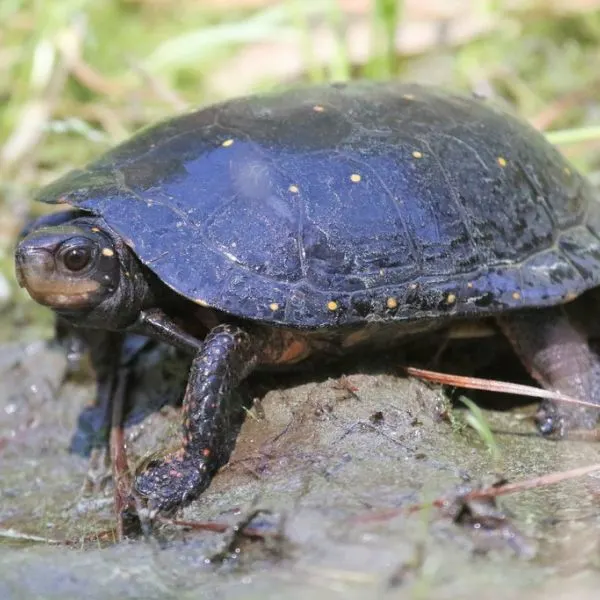
Quick Facts
- Experience Level: Beginner
- Family: Emydidae
- Scientific Name: Clemmys guttata
- Common Names: Spotted turtle
- Adult Size: 4.5 to 5 inches
- Lifespan: 26 years
- Average Price Range: $100 to $200
Quick Care Requirements
- Tank Size: 20 to 33 gallons
- Food: Live food and pre-killed food such as pinkie mice, trout chow, fish, insects, and commercial turtle diets
- UVB Lighting: Needed
- Water Temperature: 75 and 85 °F
- Basking Spot Temperature: 82 to 86 °F
The spotted turtle is a small turtle that is endemic to North America. This turtle is known as the spotted turtle because of the spots on its carapace.
The species has a dark carapace with small yellow spots which gradually disappear the older the turtle gets. The plastron is orange or yellow with a dark blotch.
The species need a water temperature below 86 degrees Fahrenheit, when the water temperature gets too high (around 88 degrees Fahrenheit or above), the species may aestivate. In this stage, it will become inactive and dormant. Aestivation is similar to hibernation. So make sure you get the heating setup right.
The species is predominantly carnivorous although adults will accept plants such as edible freshwater plants.
The small size of the turtle makes it easy to care for even for beginners. Setting up the enclosure should be inexpensive, simple, and straightforward compared to the setup of some of the turtles on here.
For more check out the Spotted Turtle Care Guide
14. Three-Toed Box Turtle

Quick Facts
- Experience Level: Beginner
- Family: Emydidae
- Scientific Name: Terrapene triunguis
- Common Names: Three-toed box turtle
- Adult Size: 5 to 7 inches
- Lifespan: 33 to 51 years
- Average Price Range: $150 – $200
Quick Care Requirements
- Tank Size: 20 to 40 gallons (an outdoor enclosure is best)
- Food: Live foods such as mealworms, superworms, earthworms, and crickets; chicken, lean beef, soaked dog food, and commercial diets; dark leafy greens, mushrooms, and fruits
- UVB Lighting: Needed
- Ambient Temperature: 70 to 80 °F
- Basking Spot Temperature: 85 °F
The three-toed box turtle gets its common name from the number of toes it has on its hind legs. They can hybridize with eastern box turtles.
The species look very similar to other North American box turtles. Apart from the number of toes on its hind legs, another unique physical characteristic of the three-toed box turtle is the shape of its carapace. The highest point of the carapace is located more to the back.
The turtle’s care is identical to that of the eastern box turtle. They accept insects, leafy greens, dog food, chicken, lean beef, mushrooms, and fruits. Check out the article on box turtle diets for more information on what they eat.
The small nature of this turtle makes housing it simple. While they are best housed outdoors, they can also be kept in a tortoise table.
This is one of the best turtles a beginner can get. Their setup is very simple and they are to feed and stimulate. They are also a great alternative to tortoises as these turtles are terrestrial. They are one of the best pet turtles for kids.
Box turtles are among the friendliest turtles.
For more check out the Three-toed Box Turtle Care Guide
15. Ornate Box Turtle
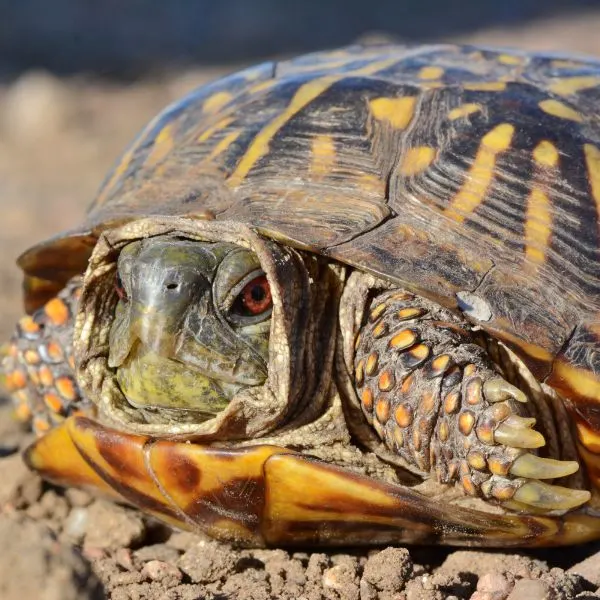
Quick Facts
- Experience Level: Beginner
- Family: Emydidae
- Scientific Name: Terrapene ornata
- Common Names: ornate box turtle
- Adult Size: 4 to 6 inches
- Lifespan: 25 to 40 years
- Average Price Range: $150 – $400
Quick Care Requirements
- Tank Size: 20 to 40 gallons or a 4 x 4 ft outdoor pen, outdoor pen preferable
- Food: Live insects, lean meat, fish, leafy greens, fruits, and vegetables
- UVB Lighting: Needed
- Temperature Range: 75 to 80 °F
- Basking Spot Temperature: 95 °F
The ornate box turtle resembles the common box turtle closely. However, the shell of this turtle is more colorful.
The series have yellow lines on their carapace and adults have yellow spots on their heads. Additionally, males have green heads and bright red eyes. These species are quite colorful.
The species can be found in the midwest in states such as Wisconsin, Kansas, Nebraska, Iowa, Colorado, and Indiana. It can be found from Wisconsin to the Gulf of Mexico.
Caring for this species is the same as that of the eastern and three-toed box turtle.
I can recommend this species to beginners because they are quite easy to care for and take up little space.
For more check out the Ornate Box Turtle Care Guide
16. Chinese Box Turtle

Quick Facts
- Experience Level: Beginner
- Family: Geoemydidae
- Scientific Name: Cuora flavomarginata
- Common Names: Yellow-margined box turtle, snake-eating turtle, golden-headed turtle, or Chinese box turtle
- Adult Size: 7.7 inches
- Average Price Range: $150 – $400
Quick Care Requirements
- Tank Size: 30 to 55 gallons
- Food: Dark leafy greens, feeder fish, insects such as waxworms and phoenix worms, slugs, and trout chow
- UVB Lighting: Needed
- Ambient Temperature: 75 to 85 °F
- Water Temperature: 75 to 80ºF
- Basking Spot Temperature: 85 to 90ºF
This turtle is endemic to China along the Yangtze, Pearl, and Fuchun Rivers in China. The species can also be found in Japan along the Tamsui River in Tiawan and Ryukyu.
In the wild, the species eat vegetation, fruits, and small animals.
Unlike North American box turtles, Asian box turtles, such as the Chinese box turtle, are more aquatic and spend considerable time in aquatic habitats such as rivers, streams, and rice patties. As such, when constructing an enclosure for the species, ensure you have a body of water for it to swim/waddle in.
I recommend that the enclosure is half terrestrial and half aquatic and the water should have a depth of three to eight inches.
While the Chinese box turtle is a bit more difficult to care for than North American box turtles such as the eastern and three-toed box turtles, caring for the species should be simple. Beginners can care for the Chinese box turtle.
I recommend this turtle to anyone who wants a turtle that is equal parts aquatic and terrestrial. They are also quite attractive and unique in appearance (they have a golden head).
17. Amboina Box Turtle

Quick Facts
- Experience Level: Intermediate
- Family: Geoemydidae
- Scientific Name: Cuora amboinensis
- Common Names: Southeast Asian box turtle, Asian box turtle, Amboina box turtle
- Adult Size: 8 inches
- Lifespan: 25 to 30 years
- Average Price Range: $150 – $400
Quick Care Requirements
- Tank Size: 30 to 55 gallons
- Food: Dark leafy greens, feeder fish, insects such as waxworms and phoenix worms, slugs, and trout chow
- UVB Lighting: Needed
- Water Temperature: 79 and 84 °F
- Basking Spot Temperature: 82 to 90 °F
This box turtle can be found in southeastern Asia. The turtle is found in several regions of its geographic range. It gets its common name from its geographic range. Even the name ‘Amboina’ refers to Ambon Island (formerly known as Amboina or Amboine) where it is a native.
Similar to the Chinese box turtle, these species require an enclosure that is both terrestrial and aquatic. They need a body of water with a depth of about 5 inches and dry land to walk on when out of water. I recommend that you provide equal parts water and land.
This box turtle is endemic to the tropics and as such requires high temperatures at all times. Temperatures shouldn’t drop below 78 degrees F.
This box turtle is much tougher to care for than North American box turtles but if you are attentive to the temperature requirements of the species, the care should be a breeze.
18. Alligator Snapping Turtle
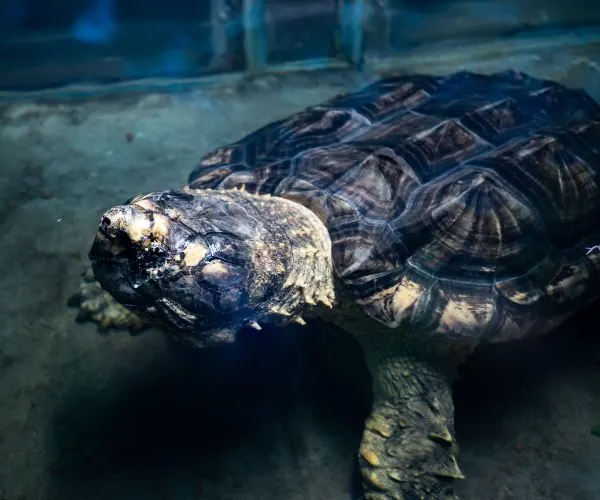
Quick Facts
- Experience Level: Intermediate
- Family: Chelydridae
- Scientific Name: Macrochelys temminckii
- Common Names: Alligator snapping turtle, alligator snapper, loggerhead snapper
- Adult Size: 14 to 32 inches
- Lifespan: 45 to 70 years
- Average Price Range: $150 – $200
Quick Care Requirements
- Tank Size: 700-gallon stock tank
- Food: fish and plant matter
- UVB Lighting: Needed
- Ambient Temperature: 80 to 85 °F
- Water Temperature: 75 to 80 °F
- Basking Spot Temperature: 85 to 92 °F
This turtle is endemic to north America from Florida to Georgia to texas. It can be found as far north as states such as Kansas and Illinois. The species’ geographic range is quite big.
The turtle is the largest freshwater turtle in North America. This turtle is known as the alligator snapping turtle because of its rough appearance. The rides on the back resemble alligator skin.
Caring for the alligator snapping turtle is relatively straightforward although they need a huge enclosure. These turtles can also be quite vicious, they have been known to cause severe injuries and are capable of biting off your fingers. Because of how dangerous they can be and their massive size, I do not recommend this turtle to beginners or children.
For more see our in-depth Alligator Snapping Turtle Care Guide
19. Common Snapping Turtle
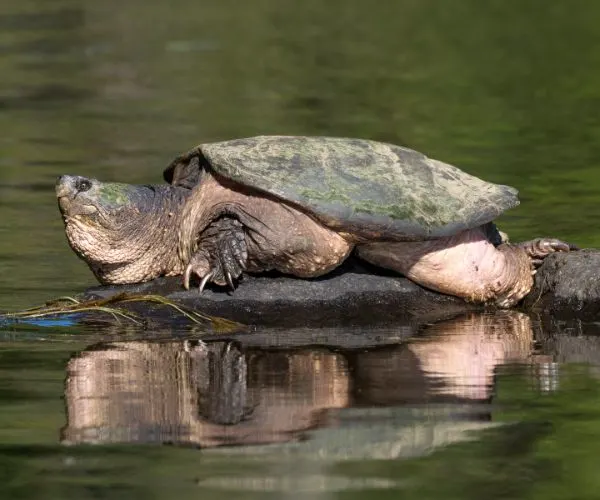
Quick Facts
- Experience Level: Intermediate
- Family: Chelydridae
- Scientific Name: Chelydra serpentina
- Common Names: common snapping turtle, snapping turtle
- Adult Size: 10 to 18.5 inches
- Lifespan: 30 to 50 years
- Average Price Range: $150 – $200
Quick Care Requirements
- Tank Size: 500 to 700 gallons
- Food: Fish and vegetables
- UVB Lighting: Needed
- Ambient Temperature: 80 to 85 °F
- Water Temperature: 75 to 80 °F
- Basking Spot Temperature: 85 to 92 °F
The common snapping turtle is known as the common snapping turtle because it is common. This turtle can be found from Canada to the Gulf of Mexico.
The species is similar in appearance to the alligator snapping turtle. However, the shell/carapace of the common snapping turtle is smooth and not rugged.
The common snapping turtle is generally considered to be more vicious than the alligator snapper although the common snapping turtle has less powerful bites. Its bites are still capable of causing severe injuries and deep cuts.
The care for these turtles is straightforward however they are dangerous and require a lot of space. For these reasons, I cannot recommend them to beginners or children including teenagers. They are, however, popular among turtle enthusiasts and are considered to be among the best pet turtle species in the world.
For more see our Common Snapper Guide
20. Spiny Softshell Turtle

Quick Facts
- Experience Level: Intermediate
- Family: Trionychidae
- Scientific Name: Apalone spinifera
- Common Names: Spiny softshell, Gulf Coast spiny softshell
- Adult Size: 5 to 19 inches
- Lifespan: 50 years
- Average Price Range: $100 – $200
Quick Care Requirements
- Tank Size: 75 to 500 gallons
- Food: fish, slugs, commercial turtle diets
- UVB Lighting: Needed
- Ambient Temperature: 75 to 85 °F
- Water Temperature: 70 to 80 °F
- Basking Spot Temperature: 90 to 100 °F
Softshells lack the hard shells of most turtles. Instead, they have a leathery carapace/shell. These turtles rely on their quick movement and camouflage for protection.
The spiny softshell has small spines on the edge of its carapace. These spines give the turtle its common name.
The spiny softshell is endemic to North America, specifically throughout most of the united and in Quebec and Ontario in Canada as well as chihuahua, Coahuila, Nuevo Leon, and Tamaulipas in Mexico. They are the most widely distributed softshell turtles in North America.
This species, while small as juveniles and hatchlings, can reach lengths of 19 inches. They need large tanks because of their size and also because they are quite messy.
They are also quite aggressive and can cause severe bites and lacerations. They can be quite tricky to care for and as such are not the best turtles for beginners.
For more see our Spiny Softshell Turtle Care Guide
21. Florida Softshell Turtle

Quick Facts
- Experience Level: Intermediate
- Family: Trionychidae
- Scientific Name: Apalone ferox
- Common Names:
- Adult Size: 6 to 29 inches
- Lifespan: 20 years
- Average Price Range: $100 – $200
Quick Care Requirements
- Tank Size: 100 to 700 gallons
- Food: fish, boiled lean meat, snails, tuna, crayfish, shrimp
- UVB Lighting: Needed
- Ambient Temperature: 75 to 85 °F
- Water Temperature: 70 to 80 °F
- Basking Spot Temperature: 90 to 100 °F
These turtles are endemic to the Southwest United States. They are called the Florida softshell because they are endemic to Florida. They can also be found in Alabama, Georgia, and South Carolina.
The Florida softshell is huge and can reach a length of 29 inches. This is over 2 feet. Their large size means that they require a massive enclosure/tank. They also are quite messy.
This turtle is best kept by experienced caretakers.
22. Yellow-Bellied Sliders

These aquatic turtles are close relatives of the red-eared sliders. Found in southern Canada to northern Mexico, their distinct yellow stripes make them easy to distinguish. They are a popular choice among beginners due to their docile nature. Like most water turtles, they require both a land area for basking and an aquatic environment. Their diet is varied, including small fish, insects, and some commercial turtle food.
23. Reeve’s Turtles

Native to parts of the Middle East and Asia, the Reeve’s turtles are known for their smaller size, making them suitable for those with less space. They are aquatic species but are not strong swimmers, so shallow water is preferred. Make sure to provide a basking area with UV light, which is essential for their health.
24. Diamondback Terrapins

These are unique aquatic turtle species found in brackish waters. They have striking diamond patterns on their shells, making them a popular choice among turtle enthusiasts. However, be aware of local laws, as in some areas, they are considered an endangered species and cannot be kept as pets.
25. Caspian Pond Turtle

Originating from the Middle East, these turtles are great pets because of their hardy nature. With their beautiful patterns, they can be a delightful addition to any home aquarium. They prefer both deep water for swimming and a basking area.
26. Greek Tortoise
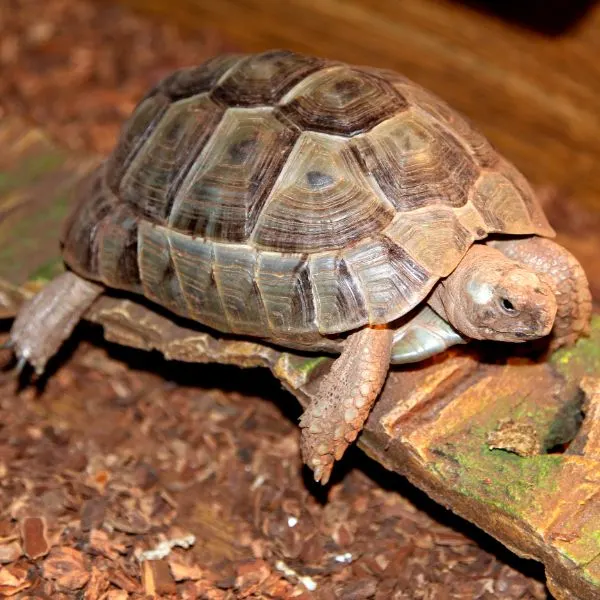
While not an aquatic species, the Greek tortoise gets an honorable mention and can be a great pet turtle for those looking for a land-based species. Their care is slightly different, and they do not need water depth like the aquatic turtles but require a varied diet, proper care, and plenty of space to roam.
For more tortoises check our guide for the best pet tortoises.
27. Northern Map Turtle

As their name suggests, these turtles have intricate map-like patterns on their shells. Native to the northern parts of North America, they require clean water and are particularly sensitive to water quality. They are best suited for more experienced keepers.
28. Mud Turtles

These are small pet turtles that can be a good choice for those who want a less demanding pet. They thrive in both shallow and deep water. However, they have a varied diet and might need special attention to their food preferences.
Tips For Turtle Care
Once you get your turtle home, there’ll be some things you should consider to make sure that you get the best experience out of your pet. While not all turtles are the same and they all require different systems, there are some common tips that you can keep in mind to care for your turtle.
1.) Depending upon the size of the turtle, always set up a large enough tank so that they can grow to their full size comfortably. While a small tank can be okay for the first few years of their life, you need to get a bigger tank when the turtles start growing bigger.
2.) Ensure that the temperature of the room and the tank are just right to make sure your turtle is comfortable. Some turtles might go into hibernation or have health issues if the temperature is too low.
3.) Keep their hibernation in mind. All turtles have different hibernation cycles, and they need to be in the right temperature range to ensure they get the best out of it.
4.) Make sure your turtle’s tank and water are cleaned regularly. If you have a tank that has a filtration system, periodically check up on it to keep it functioning properly.
5.) Don’t play too much with your turtles, as they’re prone to get stressed. While pets, like dogs and cats, might enjoy being held, turtles are more of display animal. If you hold them too often or try to play with them all the time, they might start showing symptoms of stress or health issues.
Frequently Asked Questions
What turtles don’t bite?
Most turtles don’t bite and even if they do, their bites aren’t serious and don’t break the skin. Some popular turtles that don’t bite include box turtles such as the common box turtle, cooters, sliders, and map turtles.
Turtles that are aggressive and can deliver powerful bites capable of breaking the skin and causing bleeding include softshells such as the spiny softshell and the Florida softshell, snappers such as the alligator snapper and common snapper, and mud and musk turtles. Snappers are even capable of breaking and amputating your finger so keep that in mind.
What is the easiest turtle to take care of?
This is highly subjective. However, objectively, the easiest turtle to care for is the common box turtle. My reasons for calling the common box turtle the easiest to care for are as follows.
- They aren’t picky eaters. They accept any food you offer them including fish, boiled chicken, lean meat, insects, worms, vegetables, fruits, eggs, dog food, and many more.
- They don’t require an aquatic setup. Since they are terrestrial turtles, they are turtles that don’t need water tanks or aquariums. Aquariums can be expensive to maintain as you need to filter the water and heat the water. You also need to maintain the right pH level, chlorine level, and much more.
- They don’t require a lot of space.
- They aren’t aggressive.
They are also arguably the best small turtle for beginners.
Can you have a turtle as a pet?
While most parts of the world allow you to keep captive-bred turtles as pets, you need to check the laws of your localities before you keep a turtle as a pet.
Some states such as South Dakota require that you have a Fishing/Hunting license before you can keep a wild turtle as a pet. In parts of Australia, you may need a private wildlife license to keep some turtle species as pets.
In several provinces in Canada, you need a special permit to keep several non-native turtles as pets. In Canada, native turtle species cannot be kept as pets even if the individuals are captive-bred and are shipped from a different part of the world.
Are turtles nice?
Turtles are generally nice. They generally aren’t aggressive. However, turtles are more of a display pet. As such you should limit interactions with them to a few minutes each day.
What is the best place to buy a pet turtle?
The best place to buy a pet turtle is from a local turtle breeder. If you have a pet store that sells turtles, visit them.
It’s always a plus to be able to inspect the turtle in person before you buy it. You can also visit reptile shows/expos. Another option available to you is buying online.
The main issue here is that you cannot inspect the turtle in person before you buy it. Some reputable online sellers include https://www.backwaterreptiles.com/, https://americanreptiles.com, and https://snakesatsunset.com.
Are softshell turtles good pets for first-time reptile keepers?
While they aren’t the best pets for first-timers, they are still manageable. The main issue here is their potentially large sizes and aggressive nature.
These turtles can grow to almost 2 feet. They are also aggressive especially when handled. Their strong bites and sharp claws can deliver cuts and lacerations.
Conclusion
When choosing the best turtle for your home, always consider your living conditions, available space, and your experience level. Remember, while some turtles are better suited for beginners, all require dedication, proper care, and respect for their natural habitat.
Do thorough research before bringing a new pet home and always check for any local laws or regulations regarding turtle breeds. Turtles can be a great pet for young children and adults alike if given the proper environment and care.
If you are not sure which species to start with, it might be a good idea to visit a local breeder or pet store for advice. With love and care, a turtle can be a delightful companion for years to come.

albet Abram
Monday 17th of July 2023
Best thing to do rather than buy would be to adopt. Here is a rescue in Ontario that offers adoption. https://dundasreptiles.com/ If you still insist on purchasing one, make sure to only buy from a Captive Bred breeder. Wild caught has a negative impact on the environment and they generally carry parasites and don’t adapt well to becoming caged pets.
Sandi Butler
Sunday 4th of July 2021
I have always wanted a turtle and would love to get one now. I live in FL. It needs to be in a tank on my porch/lanai as there are too many animals outside that would be dangerous. Can you please tell me if there are any that could handle the heat and humidity?
Thanks, Sandi
Nightnurse4jah
Sunday 17th of January 2021
Now I'm even more confused than when i started 😒
Brock Yates
Sunday 17th of January 2021
How so? Email us at [email protected] so we can try to help you
Emma
Tuesday 1st of December 2020
10-20 gallons is absolutely inappropriate for a red-eared slider, at the minimum they need at least a 40 gallon tank!! they're extremely messy and need plenty of room to swim
Ryan Lewis
Tuesday 4th of January 2022
@Emma, A RES needs at least 10 gallons per inch of shell. So if you have an 8" RES you need a 80 gallon tank. Its best to start with the size of tank they will grow into. I have a 10" RES and have him in a 90 gallon take and he really could use the extra 10 gallons.
Jill Snodgrass
Thursday 12th of November 2020
I live in Tulsa Ok. I have recently rescued a box turtle. We have a vet appt tomorrow and will determine if the little girl can be released and remain healthy or if it needs to remain with me. I love her and have become quite attached and intrigued with this turtle thing. If she cannot be released, I want a mate for her. I need a turtle rescue in Oklahoma that I could adopt from.